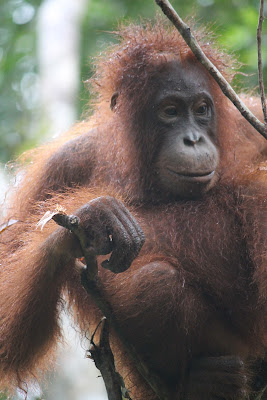And, finally, what you've been waiting for... orangutans!!
I have included an absurd number of photos in this blog post, but it barely scratches the surface of all the shots I actually took. Feel free to check out the full album if you're bored. Eileen also has some great pics.
Still waiting on Jenny's photos... Jenny!!!! *Shakes fist in the air*
A little bit of background on orangutans, for your edification:
Did you know that orangutan means "forest person" in Indonesian (orang = person/people, hutan = forest)? Well, now you know, and knowing is half the battle.
Also, you should know that orangutans are gravely endangered, with some
estimating that they will be extinct in the wild within 10 years. The
main threat to their existence is rapid deforestation on the islands of Sumatra and Borneo, the only places that orangutans live in the wild. The deforestation is largely due to illegal logging for purposes of planting palm oil plantations as well as making wood and paper products. Orangutans live 95% of their time in the forest canopy and rely on the forest for shelter and food, so without it, they are basically SOL. Many of the orangutans in Tanjung Puting National Park are rehabilitated
(or the offspring of rehabilitated orangutans) meaning that they were
saved from the illegal pet trade or found wandering after their habitat
was razed and replaced with a palm oil plantation. After their
rehabilitation, they were released into the forest in the park and are
now semi-wild, living on their own and foraging for food in the forest,
but returning to feeding stations in the park when food is scarce in the
forest.
About two hours after hopping on our klotok and leaving the port at Kumai, not long after gawking at the troop of proboscis monkeys, and once the rain slowed a bit, we hopped off the boat at our first stop: Tanjung Harapan. Part of Tanjung Puting National Park, Tanjung Harapan (which roughly translate to Cape Hope or Hope Point) is one of the former release/current feeding sites for the orangutans living in the park.
We first stopped to look at the map in the mini-village that houses some of the Orangutan Foundation/park staff, then hiked into the forest about 20 minutes when we stumbled upon this guy below, our first orangutan sighting:
After marveling over this guy for a few minutes, we spotted more and more orangutans, kicking it in the trees. Absolutely amazing. And yes, orangutans spend approximately 80% of their day in hanging from trees in awkward looking spread eagle positions, based on my scientific research and photo documentation:
The other 20% of their time is spent looking pensive and/or eerily human. A reminder of how close they are to us on the evolutionary ladder:
It just got better and better as we got closer to the feeding station, one of several raised wooden platforms from which the park staff feed the rehabilitated orangutans (as well as some wild ones who show up for a snack when there is little fruit available in the forest). Each day the park staff bring fruit and vitamin-enriched milk to the platform for the orangutans to supplement their diet of fruit gathered from the ever dwindling forest habitat.
These orangutans were loitering near the food station, sticking to the trees on the outskirts of the feeding area until lunch was actually served. Orangutans are typically pretty solitary animals, so I think they are a little wary about being around other orangutans (and people, for that matter), particularly other males, in this situation.
When the food and drink showed up, however, it was party time and orangutans started coming out of the woodwork... literally:
Angling for space on the platform, or just grabbing a bite to go (di bungkus, these guys might say), the orangutans are all about the cassava that the park rangers brought:
Even some moms and toddlers joined the dinner party:

The milk was a big hit for the orangutans, and watching their various drinking methodologies and resultant milk mustaches was a big hit for us as observers.
Moustaches/beards:
1. The Head Dip/Feeding Trough Method:
2. The Shower/Is There Anything In Here Method:
Method #3, the Scoop, Pout and Pour Method will be documented in a later blog post. This one is already too unwieldy and must be broken into two.




































Check out Marion Nestle's Nov 21 post on the proposed Nutella tax in France as it relates to health/industry propaganda/palm oil. Is Nutella France's equivalent of high fructose corn syrup? http://www.foodpolitics.com/
ReplyDelete